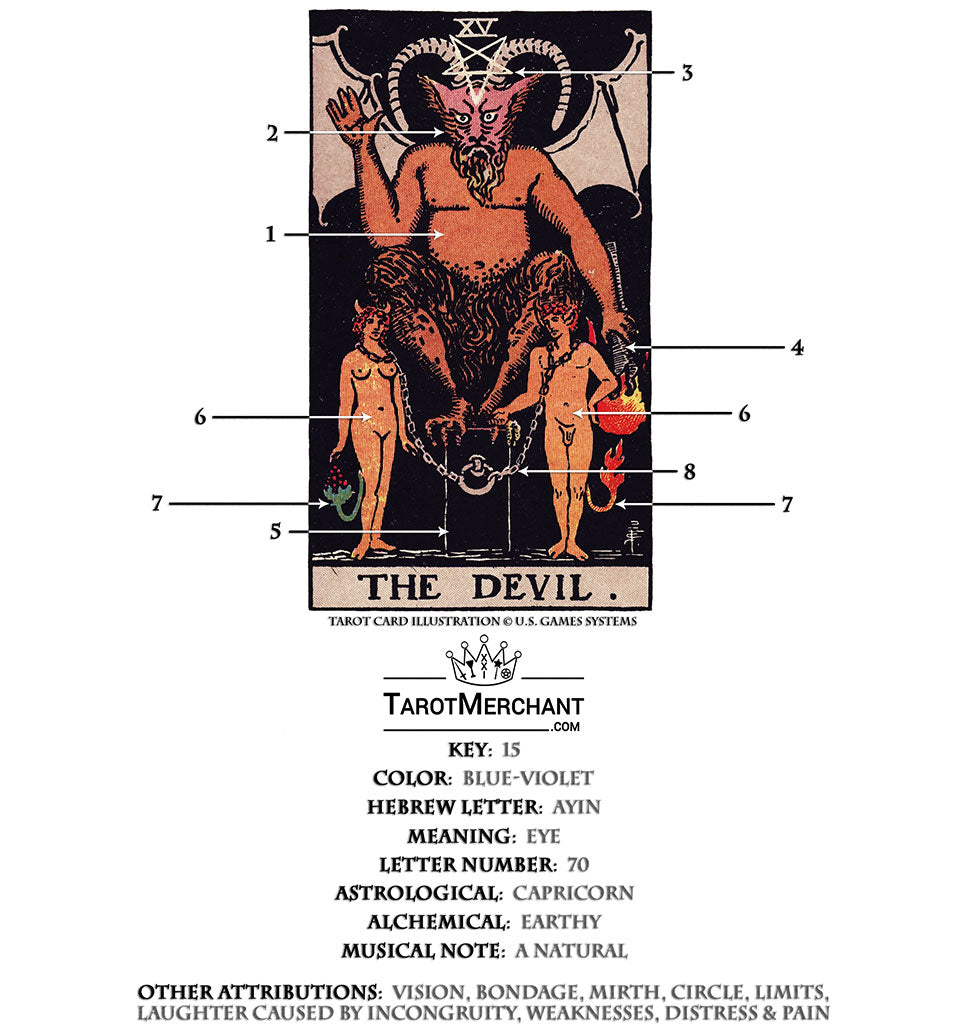The Devil tarot card, often misunderstood and shrouded in negative connotations, transcends mere sinister interpretations. At its core, this card represents a pivotal juncture, a juncture that beckons introspection and a recalibration of one’s perspective. In this article, we shall delve deeply into the multifaceted meanings of the Devil tarot card, illuminating its implications in various contexts, and illuminating the essence of its symbolism.
First and foremost, the imagery depicted on the Devil card is arresting. A capricious figure, oftentimes flanked by chains shackled to two humans, strikes a daunting posture. The obdurate stance of the Devil, symbolizing temptation and indulgence, has elicited myriad interpretations throughout history. Many may perceive this as merely an archetype of malevolence, yet to label the card solely as a harbinger of doom is to overlook its profound teaching potential.
Rather than representing malignancy, the Devil card can signify bondage – not the physical kind but rather the bondage of the psyche. These chains often symbolize self-imposed limitations, representing our fears, dependencies, and negative patterns that often dictate our existence. The card urges individuals to confront these constraints rather than surrender to them. It raises a critical inquiry: What binds you? What habits or beliefs ensnare you, inhibiting your growth and evolution?
This card also embodies the themes of temptation and desire, illustrating the struggle between our carnal instincts and spiritual aspirations. This duality manifests as a myriad of choices we face daily. The card does not condemn desire; instead, it prompts a contemplation of what desires we should cultivate. Are they enriching our lives or leading us into a quagmire of excess? The Devil, in this light, serves as a reminder that unchecked desires can lead to detrimental outcomes, but moderate indulgence can foster creativity, joy, and fulfillment.
Transitioning from personal introspection to interpersonal dynamics, the Devil card can shine a light on toxic relationships and environments. It serves as a clarion call to examine those attachments: Do they propel you forward or anchor you down? Recognizing these relationships is crucial in our journey toward self-liberation and awakening. The card’s portrayal of subjugation implores one to break free from unhealthy interactions that tend to drain one’s energy and impede personal progress.
Interestingly, the Devil card also emphasizes the importance of self-awareness. As one navigates the labyrinth of life, becoming cognizant of one’s patterns, triggers, and boundaries is paramount. It invites a conscientious assessment of the choices made and their reverberations in one’s life. This card embodies the profundity of self-reflection, revealing how our psyche can sometimes become our worst enemy, ensnaring us in cycles of fear and self-doubt.
Moreover, the context of the reading determines the card’s unique implications. When the Devil appears in a reading regarding work, it may signal a warning against overworking or falling prey to career-related compulsions. Conversely, if the query pertains to relationships, it could unveil unhealthy dynamics, underscoring the necessity for transparency and emotional honesty. The card serves as both a shield and a sword: a protective reminder to shield oneself from destructive behaviors while also wielding the courage to confront them head-on.
In terms of guidance, the Devil card advocates for understanding and acceptance. Recognizing and embracing our flaws, vulnerabilities, and desires can be incredibly empowering. Healing occurs not through denial but through acknowledgment. To embrace your inner Devil is to foster a robust relationship with your authentic self, ultimately allowing for transformation and transcendence.
Upon culmination of the exploration of the Devil tarot card, one cannot overlook its transformative potential. While it may initially seem daunting, this card serves as a powerful archetype advocating for liberation through acknowledgment and understanding. It cultivates an awareness of the innate, often contradictory aspects of human existence, urging seekers to embark on a journey of self-discovery and reflection.
As curiosity lingers, one must ponder: How can the insights gleaned from the Devil card facilitate personal growth? It challenges individuals to view their lives through a different lens, shifting the narrative from one of victimization to one of empowerment. Ultimately, embracing the lessons of the Devil card can catalyze profound personal metamorphosis, revealing that shadows can illuminate rather than obscure.
In conclusion, the Devil tarot card embodies complexity. Stripped of misconceptions, it emerges as a beacon for introspection. By examining the chains that bind us, the desires that drive us, and the relationships that shape us, we are offered an opportunity to reclaim our power. The Devil’s profound messages reverberate through the corridors of consciousness, beckoning each individual toward a more liberated existence. In the dance between shadow and light lies the crux of human experience; it is within these nuances that we find the courage to confront, accept, and ultimately transform.









Leave a Comment